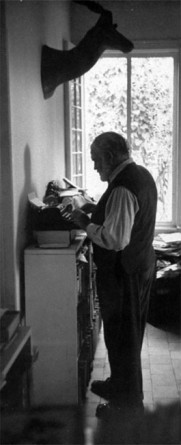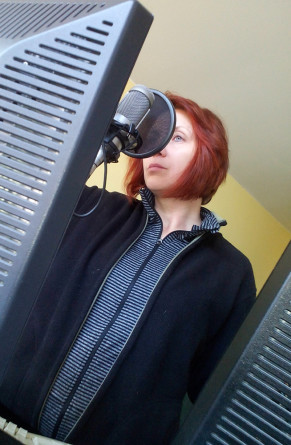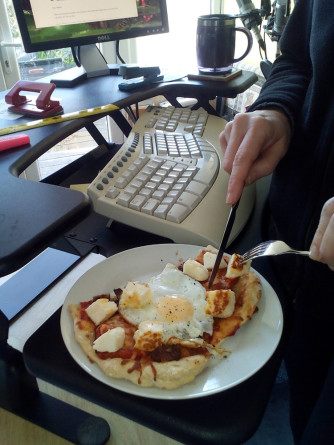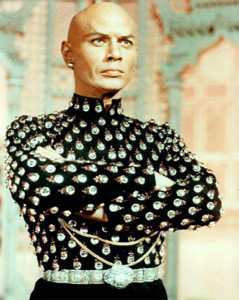PLEASE BE UPSTANDING
Too much sitting isn’t good for you. Studies have shown that sitting for more than 4 hours each day increases insulin and blood pressure levels, reduces calorie burning, and shuts down the enzymes responsible for burning harmful blood fats.
On average, we Brits sit for 8.9 hours each day; 10 hours for office workers. In 2015, the UK’s first official health guidelines called for office workers to be on their feet for at least 2 hours during their working day. According to the British Journal of Sports Medicine, UK sedentary behaviour accounts for 60% of the population’s waking hours, and researchers say excessive and prolonged sitting can lead to increased risk of:
• Backache
• Diabetes (T2)
• Heart disease
• Muscle degeneration
• Obesity
• Thrombosis

Standing desks have been around for a while: Leonardo Da Vinci used one; Winston Churchill and Napoleon Bonaparte preferred to work standing ; works by Charles Dickens, Virginia Woolf and Ernest Hemingway were written standing up; and Thomas Jefferson designed his own desk that included an adjustable work surface to allow him the option of sitting or standing.
Today, that Sit-Stand option is becoming more popular—in Sweden and Denmark, 90% of office workers use Sit-Stand desks—and I’ve been trying one out for the last few weeks. The two-tier Varidesk Pro Plus 36 came already assembled; I just cleared my desk, placed the box on top and slid out the Varidesk. Couldn’t have been easier. Raising and lowering the desk is also uncomplicated and effortless: just a squeeze of the side levers plus a gentle lift or push down.
Rather than have one of those giant monitors that feel like they belong on the bridge of the Enterprise, I prefer to work with two 17cm monitors (my brain likes the separation of church and state this set-up offers; plus I love it when my cursor jumps from screen to screen), and there’s plenty of room for my twin screens—plus paperwork, my mobile phone and a cup of tea—on the upper shelf. The lower deck is also roomy, which I need to accommodate my larger-than-normal curved ergonomic keyboard.
 Standing to work isn’t new to me. When I regularly presented radio programmes, I always preferred the studios that offered the option to stand: it’s better for breathing; allows more freedom to be animated while talking; and provides a feeling of being in command that sitting just doesn’t deliver. Standing at the Varidesk while on the phone (with my lip-mic headset) recreates that in charge feeling: like Yul Bryner’s King of Siam, everyone’s head is lower than mine.
Standing to work isn’t new to me. When I regularly presented radio programmes, I always preferred the studios that offered the option to stand: it’s better for breathing; allows more freedom to be animated while talking; and provides a feeling of being in command that sitting just doesn’t deliver. Standing at the Varidesk while on the phone (with my lip-mic headset) recreates that in charge feeling: like Yul Bryner’s King of Siam, everyone’s head is lower than mine.
The other day I had breakfast at my desk; my raised desk. And I wondered if standing while eating is a good thing. The answer: it depends.
We burn more calories standing than we do sitting; the difference is about 50 calories per hour. Standing for 3 hours per day for five days will burn 750 more calories per week than sitting for those hours. Replicate that over a year and the calorie count is in excess of 30,000. Or about 4kg of fat (about 9lbs).
Sounds good.
But …

When we stand, we tend to eat faster, which means we’re likely to consume more food before we feel full (that takes about 20 minutes). So unless you make an effort to eat slowly, eating standing up could cancel out (or overtake) all those calories you burn by working standing up. So take care when grabbing lunch at your Sit-Stand desk.
However, it’s not just eating we do faster standing up; apparently we do everything faster: for example, one study found that meetings that took place sitting lasted 34% longer than standing meetings. And, while I haven’t morphed into the Flash, over the last few weeks at my Varidesk I have felt more energised and I’m cutting through my workload like a warmed up piece of cutlery through a solid dairy product. It’s fair to say I love my Varidesk.
That’s not to say I stand all the time. Just like chocolate, waxing, and Storage Hunters, you can have too much of a good thing. Standing all day, like sitting all day, is not a good idea. If you regularly work too long in a standing position you reduce the blood supply to your loaded muscles, and consequences you can expect include (but are not limited to) sore feet, swollen legs, general muscular fatigue, low back pain, stiffness in the neck and shoulders.
The key to making the Varidesk work for you is in the name. Work sitting for a while; work standing for a while. Vary how you work.
If you still need convincing that you need to get out of your chair more at work, consider this:
• Immediately after you sit down, the electrical activity in your muscles slows down
• 2 weeks of sitting for more than 6 hours per day will see your muscles start to atrophy and your blood sugar levels rise
• 1 year later you can expect to have put on weight
• After 20 years, your risk of dying of heart disease will have increased by 64%
Of course if you really can’t get your head around standing and typing, or standing and talking, or standing and thinking, you don’t have to have a Varidesk (other Sit-Stand desks are available). The advice is to stand up and move about a little every hour, and make sure you get 30 minutes of exercise each day (walking will do).
But just remember, next time you call me, I’ll be the King of Siam.
FACT BOX
VARIDESK sell a wide range of adjustable height desks
Guidance published in BRITISH JOURNAL OF SPORTS MEDICINE: For those occupations which are predominantly desk based, workers should aim to initially progress towards accumulating 2 h/day of standing and light activity (light walking) during working hours, eventually progressing to a total accumulation of 4 h/day (prorated to part-time hours)
Chantal Cooke is an award winning journalist and broadcaster with a passion for the planet. In 2002 she co-founded the award winning radio station PASSION for the PLANET and in 2009 Chantal was awarded London Leader in Sustainability status. Chantal also runs a successful communications agency – Panpathic Communications.


